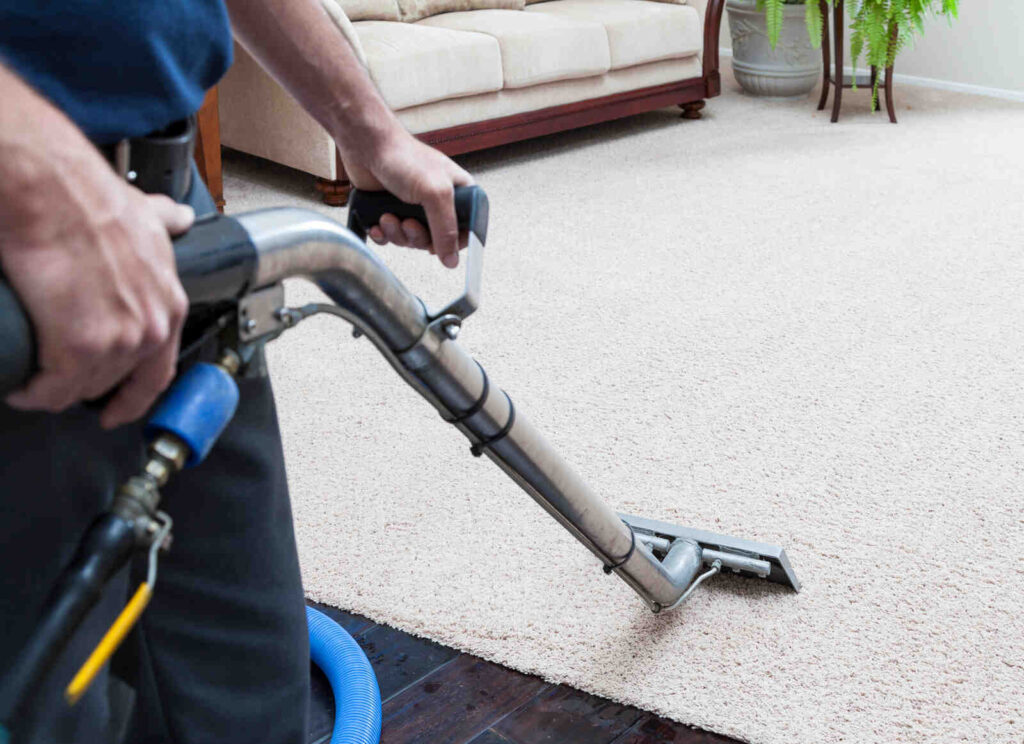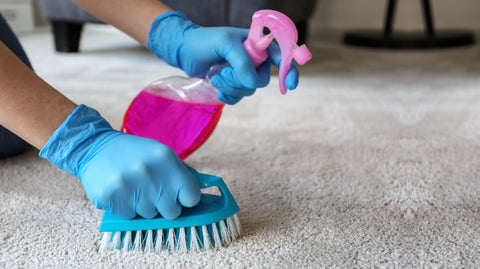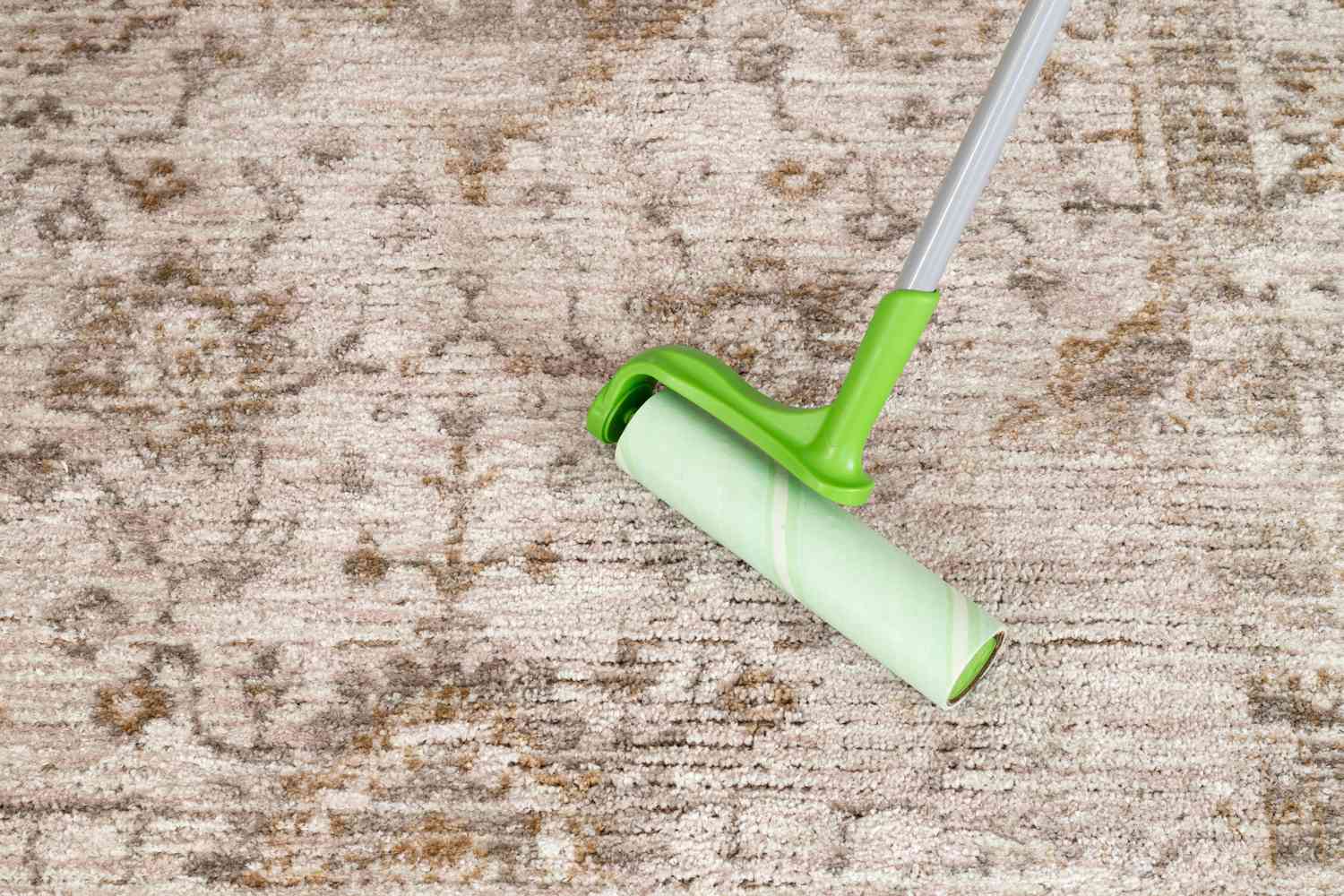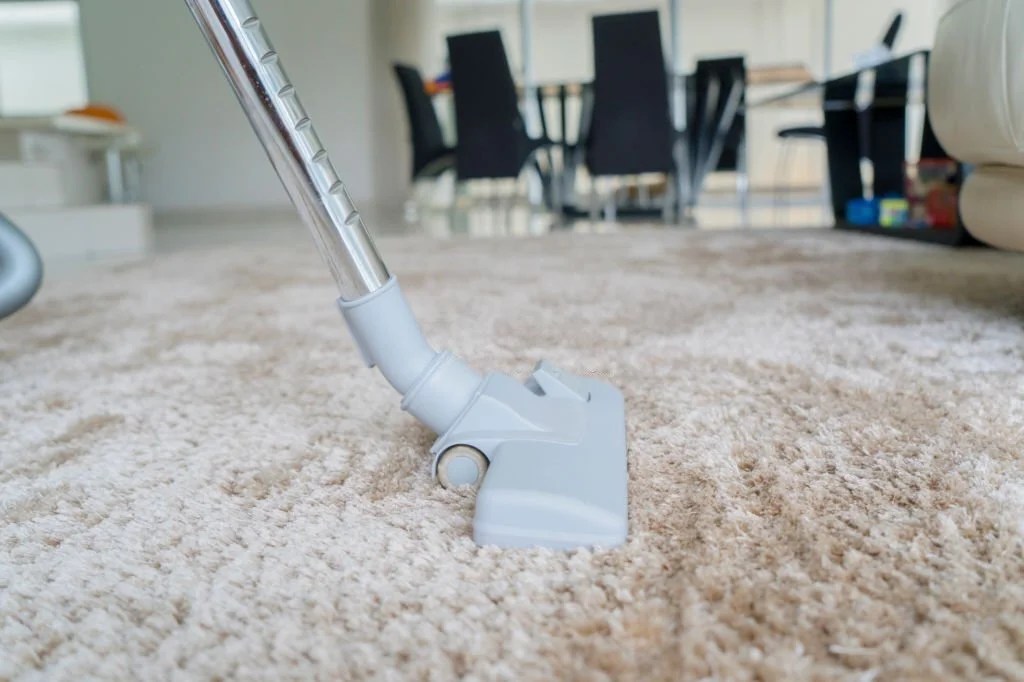Cleaning a rug without a vacuum is possible. You can achieve a fresh, clean rug using simple tools and techniques.
Many people don’t own a vacuum cleaner or prefer not to use one. Others face challenges like power outages or limited access to electricity. Regardless, knowing how to clean a rug without a vacuum is handy. You can easily remove dirt, dust, and stains with basic household items.
This guide will show you effective methods to keep your rug clean and fresh without relying on a vacuum cleaner. Discover practical tips and tricks that are simple to follow and require minimal effort. Let’s dive into this helpful and accessible rug-cleaning process.

Preparing The Rug
Cleaning a rug without a vacuum might seem challenging, but with the right steps, you can achieve great results. The first step is preparing the rug. Proper preparation ensures effective cleaning and prevents damage. Let’s dive into the steps for preparing your rug for a thorough clean.
Remove Loose Items
Start by removing any loose items on the rug. These can include toys, shoes, and other household items. Clearing the rug of these items will make the cleaning process easier and more efficient.
- Pick up toys: Ensure all toys are off the rug. This will prevent them from getting in the way during cleaning.
- Remove shoes: Shoes can carry dirt and debris. Removing them helps keep the rug cleaner.
- Gather small items: Small items like coins, paper clips, and other objects should be collected and removed.
After removing loose items, inspect the rug for any larger debris. Use a broom or a soft-bristle brush to gently sweep away dirt and crumbs. For stubborn debris, consider using a lint roller. This tool is excellent for picking up small particles that a broom might miss.
| Tool | Purpose |
| Broom | Sweeping away dirt and crumbs |
| Soft-bristle brush | Gently removing debris |
| Lint roller | Picking up small particles |
Once you have cleared the rug of loose items and debris, you are ready to move on to checking for stains.
Check For Stains
Inspecting the rug for stains is a crucial step. Identifying stains early allows you to treat them effectively. Follow these steps to check for and address stains:
- Visual inspection: Look for visible stains. Common stains include spills, pet accidents, and dirt marks.
- Smell test: Use your nose to detect any unusual odors. Odors can indicate hidden stains or mildew.
- Spot cleaning: Once you locate stains, prepare a simple cleaning solution. Mix one part white vinegar with two parts water. Apply the solution to the stain using a clean cloth.
Gently blot the stain with the cloth. Avoid rubbing, as this can spread the stain. Continue blotting until the stain lifts. For tough stains, you may need to repeat the process or use a specialized cleaner.
Here’s a quick reference table for treating common stains:
| Type of Stain | Cleaning Solution | Application Method |
| Pet stains | White vinegar and water | Blot with a cloth |
| Food spills | Mild dish soap and water | Gently scrub with a brush |
| Ink stains | Rubbing alcohol | Blot with a cloth |
Addressing stains immediately prevents them from setting in and becoming more difficult to remove. Once the stains are treated, your rug is ready for the next cleaning steps.
Gathering Cleaning Supplies
Cleaning a rug without a vacuum might seem challenging, but with the right supplies, it becomes an easy task. The key is to gather essential tools and effective cleaning solutions. Let’s dive into the specifics of what you need to get started.
To Get The Best Rug Cleaning Service – Click Here
Essential Tools
To clean a rug without a vacuum, you need several basic tools. These items help you remove dirt, dust, and debris effectively.
- Broom: A stiff-bristled broom is great for sweeping away surface dirt.
- Dustpan: Collect the dirt you sweep up with a sturdy dustpan.
- Rug Beater: If you have access to one, a rug beater is excellent for loosening deep-set dirt.
- Scrub Brush: A brush with firm bristles helps in scrubbing stains and spills.
- Bucket: Essential for mixing cleaning solutions and water.
- Microfiber Cloth: Useful for spot cleaning and wiping down the rug.
Here’s a quick overview in table format:
| Tool | Purpose |
| Broom | Sweep surface dirt |
| Dustpan | Collect swept dirt |
| Rug Beater | Loosen deep dirt |
| Scrub Brush | Scrub stains |
| Bucket | Mix cleaning solutions |
| Microfiber Cloth | Spot cleaning |
Having these tools on hand will make the cleaning process smoother and more efficient.
Cleaning Solutions
Choosing the right cleaning solutions is crucial. You want something effective yet gentle on your rug’s fibers.
- Vinegar and Water: Mix equal parts of vinegar and water for an all-purpose cleaner. This solution works well for most stains and odors.
- Baking Soda: Sprinkle baking soda over the rug to absorb odors. Leave it for 15 minutes, then sweep it up.
- Dish Soap and Water: Mix a few drops of dish soap in water. This is great for spot cleaning stains.
- Hydrogen Peroxide: For tough stains, a mix of hydrogen peroxide and water can be effective. Be sure to test it on a small area first.
Here’s a summary in table format:
| Cleaning Solution | Purpose |
| Vinegar and Water | All-purpose cleaner |
| Baking Soda | Odor absorption |
| Dish Soap and Water | Spot cleaning stains |
| Hydrogen Peroxide | Tough stain removal |
Make sure to test any cleaning solution on a small, hidden part of the rug first. This ensures that it won’t cause damage or discoloration.
With these essential tools and cleaning solutions, you’re well-equipped to clean your rug effectively without a vacuum.
Dry Cleaning Method
Cleaning a rug without a vacuum might seem tough, but the dry cleaning method can make it easy. This method is great for keeping your rug fresh and clean. Let’s explore two effective techniques: using baking soda and the brushing technique.
Using Baking Soda
Baking soda is a fantastic tool for cleaning rugs. It’s natural and safe for most rug materials. Here’s how you can use it:
- Sprinkle baking soda: Evenly sprinkle a generous amount of baking soda over the entire rug. Ensure it covers all the areas you want to clean.
- Let it sit: Allow the baking soda to sit on the rug for at least 30 minutes. For tougher odors, let it sit overnight. This gives the baking soda time to absorb dirt and odors.
- Brush the rug: Use a soft-bristle brush to gently work the baking soda into the rug fibers. This helps in loosening dirt trapped in the fibers.
- Shake or beat the rug: Take the rug outside and shake it to remove the baking soda. You can also hang it and beat it with a stick or broom.
- Vacuum alternative: If you don’t have a vacuum, use a handheld broom or brush to sweep the remaining baking soda off the rug.
Baking soda not only cleans but also deodorizes your rug. It’s a simple and effective method to keep your rug looking and smelling fresh.
Brushing Technique
The brushing technique is another excellent way to clean your rug without a vacuum. It requires a bit of effort but gives great results. Here’s how to do it:
- Select the right brush: Choose a brush with soft to medium bristles. Avoid using hard bristles as they can damage the rug fibers.
- Brush in sections: Divide your rug into small sections. This makes the cleaning process more manageable and ensures thorough cleaning.
- Brush gently: Start brushing each section gently in the direction of the rug fibers. Use short, firm strokes to lift dirt and dust out of the fibers.
- Focus on problem areas: Pay extra attention to high-traffic areas and spots with visible dirt. You may need to brush these areas more thoroughly.
- Shake out the rug: Once you’ve brushed the entire rug, take it outside and give it a good shake. This helps remove the loosened dirt and debris.
Brushing not only cleans the rug but also helps maintain its appearance by keeping the fibers aligned and fluffy. It’s a great method for regular maintenance, especially if you don’t have access to a vacuum cleaner.

Spot Cleaning Stains
Cleaning a rug without a vacuum can be a daunting task, especially if there are stubborn stains. One crucial aspect is spot cleaning stains. This method targets specific dirty areas, ensuring your rug looks clean and fresh. Let’s explore effective ways to tackle these stains.
To Get The Best Rug Cleaning Service – Click Here
Homemade Solutions
Homemade solutions can be highly effective for spot cleaning stains on rugs. These solutions use common household items that are both affordable and non-toxic. Below are some popular homemade solutions:
- Vinegar and Water: Mix equal parts of white vinegar and water in a spray bottle. This solution works well on most stains.
- Baking Soda and Water: Create a paste by mixing baking soda with a small amount of water. This paste is great for absorbing grease and oil stains.
- Dish Soap and Water: Combine a few drops of dish soap with warm water. Use this solution for general stain removal.
For easier reference, here’s a table summarizing these solutions:
| Solution | Ingredients | Usage |
| Vinegar and Water | 1 cup vinegar, 1 cup water | General stains |
| Baking Soda and Water | 1/2 cup baking soda, water to form paste | Grease, oil stains |
| Dish Soap and Water | Few drops of dish soap, warm water | General stains |
These solutions are easy to prepare and use. Always test the solution on a small, hidden area of the rug first. This will ensure it doesn’t cause any discoloration or damage.
Blotting Technique
The blotting technique is essential for effective spot cleaning. Blotting helps lift the stain without spreading it further. Here’s how to do it:
- Start Immediately: Address the stain as soon as possible. Fresh stains are easier to remove than dried ones.
- Blot, Don’t Rub: Use a clean cloth or paper towel to gently blot the stain. Rubbing can push the stain deeper into the rug fibers.
- Use a Solution: Apply one of the homemade solutions mentioned above to the stained area. Spray or dab the solution, then continue blotting.
- Repeat: Repeat the process until the stain is removed. Patience is key for tough stains.
- Dry the Area: After removing the stain, use a dry cloth to blot the area until it’s dry. This helps prevent any remaining moisture from causing mold or mildew.
Blotting technique tips:
- Use white cloths: Colored cloths can transfer dye to the rug.
- Work from outside in: This prevents the stain from spreading.
- Use light pressure: Too much pressure can damage rug fibers.
By following these steps and tips, you can effectively clean stains without a vacuum. Consistent care will keep your rug looking its best.
Washing The Rug
Cleaning a rug without a vacuum might seem challenging, but it’s quite manageable with the right steps. Washing the rug is a crucial part of the process. This not only removes dirt but also eliminates any stubborn stains. By washing the rug carefully, you ensure it stays fresh and clean.
Hand Washing Steps
Hand washing your rug involves a few simple steps. Begin by shaking off any loose dirt and debris. This prepares the rug for a deeper clean. Next, gather your cleaning supplies. You will need:
- A mild detergent or rug shampoo
- A soft-bristled brush or sponge
- A bucket of warm water
Start by mixing the detergent with warm water in the bucket. Follow the instructions on the detergent bottle for the right amount. Test the cleaning solution on a small, hidden area of the rug first. This ensures it does not damage the colors or fibers.
Once you are sure the solution is safe, dip the brush or sponge into the soapy water. Gently scrub the rug in a circular motion. Focus on areas with stains or heavy dirt. Be careful not to use too much water, as this can damage the rug.
Continue scrubbing the entire rug. Work in sections to ensure you cover the whole area. If you encounter tough stains, let the soapy water sit on the stain for a few minutes before scrubbing again. This helps to break down the stain, making it easier to remove.
To Get The Best Rug Cleaning Service – Click Here
Rinsing Process
After thoroughly scrubbing the rug, it’s time to rinse. Proper rinsing is essential to remove all soap residue, which can attract more dirt if left behind. Here is how you can rinse your rug effectively:
Fill a clean bucket with cold water. Using cold water helps to preserve the rug’s colors and fibers. Dip a clean sponge or cloth into the water. Wring out the excess water to avoid soaking the rug.
Wipe the rug gently with the damp sponge or cloth. Work in sections, just like you did while scrubbing. Make sure to rinse the sponge or cloth frequently to avoid spreading soap back onto the rug.
For larger rugs, you might need to use a hose. Take the rug outside and lay it flat on a clean surface. Use a gentle spray setting on the hose to rinse the rug. Avoid using high pressure, as it can damage the fibers.
Once you have rinsed the entire rug, check for any remaining soap residue. If you find any, repeat the rinsing process. It is crucial to remove all soap to keep the rug clean for longer.
After rinsing, allow the rug to dry completely. Hang it over a railing or lay it flat in a sunny area. Ensure there is good airflow to speed up the drying process. Avoid placing the rug back inside until it is fully dry to prevent mold and mildew.
Drying The Rug
Cleaning a rug without a vacuum can be a challenging task. Once you’ve cleaned your rug using alternative methods, drying it properly is crucial. Proper drying ensures your rug stays fresh and free from mold or mildew. Here are some tips to help you dry your rug efficiently.
Air Drying Tips
Air drying is one of the best methods to dry your rug naturally. Follow these steps to ensure your rug dries thoroughly:
- Shake Off Excess Water: After washing your rug, gently shake it to remove excess water. This step speeds up the drying process.
- Lay Flat: Place the rug flat on a clean, dry surface. This helps maintain the rug’s shape and prevents wrinkles.
- Elevate the Rug: Use a drying rack or place the rug on a raised platform. Elevating the rug allows air to circulate underneath, speeding up the drying process.
- Turn Frequently: Flip the rug every few hours. This ensures even drying on both sides.
- Use Fans: Place fans around the rug to increase air circulation. This helps dry the rug faster.
| Step | Action |
| 1 | Shake off excess water |
| 2 | Lay flat on a clean surface |
| 3 | Elevate the rug |
| 4 | Turn frequently |
| 5 | Use fans for better air circulation |
These tips help ensure your rug dries evenly and thoroughly. Proper air drying prevents mold and keeps your rug smelling fresh.
Avoiding Direct Sunlight
While sunlight can help dry your rug, direct sunlight can cause damage. Here are some tips to avoid the negative effects of direct sunlight:
- Shade the Rug: Place your rug in a shaded area. This helps avoid direct sunlight while still allowing the rug to dry.
- Use a Canopy: If you don’t have a shaded area, use a canopy or a large sheet. This provides shade and protects the rug from harsh sunlight.
- Indoor Drying: Dry your rug indoors near an open window or in a well-ventilated room. This allows air to circulate without exposing the rug to direct sunlight.
- Monitor Drying: Check your rug frequently. Move it if it starts to receive direct sunlight.
- Rotate the Rug: Rotate your rug periodically. This ensures all parts of the rug dry evenly without prolonged sun exposure.
Direct sunlight can fade colors and weaken rug fibers. By following these tips, you can avoid potential damage and keep your rug looking new.
Deodorizing The Rug
Cleaning a rug without a vacuum might seem challenging, but it is achievable. One crucial step is deodorizing the rug. This step removes unpleasant smells and leaves the rug fresh and clean. Various natural methods can deodorize a rug effectively, ensuring it smells as good as it looks.
To Get The Best Rug Cleaning Service – Click Here
Using Natural Deodorizers
Natural deodorizers can work wonders on a rug. They are safe, eco-friendly, and often already in your kitchen.
Baking soda is a popular choice. It absorbs odors and moisture, making it a powerful deodorizer. Sprinkle a generous amount of baking soda on the rug. Let it sit for a few hours, allowing it to absorb any smells. Then, sweep or shake off the baking soda. This simple method leaves the rug smelling fresh.
Another effective natural deodorizer is white vinegar. Vinegar neutralizes odors and disinfects. Mix equal parts of vinegar and water in a spray bottle. Lightly mist the rug with the solution. Be careful not to soak it. Let the rug air dry completely. The vinegar smell will dissipate, taking any unpleasant odors with it.
Lemon juice also works well. It has a fresh scent and antibacterial properties. Mix lemon juice with water and spray it on the rug. Let it dry naturally. The rug will have a light, pleasant citrus scent.
| Natural Deodorizer | How to Use |
| Baking Soda | Sprinkle, wait a few hours, then sweep off |
| White Vinegar | Spray with water mix, let dry |
| Lemon Juice | Spray with water mix, let dry |
These natural options are effective and easy to use. They help maintain a fresh and clean rug without harsh chemicals.
Essential Oils
Essential oils add a pleasant fragrance to your rug. They are natural and have various benefits beyond deodorizing.
Lavender oil is a great option. It has a calming scent and antibacterial properties. Mix a few drops of lavender oil with water in a spray bottle. Lightly spray the rug and let it air dry. The rug will smell lovely and fresh.
Another good choice is tea tree oil. It has a strong scent and is known for its antibacterial qualities. Mix a few drops with water and spray the rug. Let it dry completely. This method not only deodorizes but also disinfects the rug.
For a refreshing scent, try peppermint oil. It has a strong, invigorating aroma. Mix a few drops with water and spray the rug. Allow it to dry naturally. Peppermint oil leaves a crisp, fresh scent that lingers.
Here is a simple table to guide you:
| Essential Oil | Properties | How to Use |
| Lavender Oil | Calming, Antibacterial | Mix with water, spray, let dry |
| Tea Tree Oil | Antibacterial, Strong scent | Mix with water, spray, let dry |
| Peppermint Oil | Refreshing, Invigorating | Mix with water, spray, let dry |
Using essential oils is an easy and effective way to keep your rug smelling great. Choose your favorite scent and enjoy a fresher home.

Maintaining Rug Cleanliness
Keeping your rug clean without a vacuum may seem challenging, but it’s entirely possible with the right approach. Maintaining rug cleanliness involves a combination of regular cleaning routines and preventative measures. This ensures your rug stays fresh, vibrant, and free from dirt and allergens.
Regular Cleaning Schedule
Establishing a regular cleaning schedule is key to keeping your rug clean. This helps to remove dirt and debris before they become embedded in the fibers. Here are some effective methods:
- Shaking and Beating: Take your rug outside and shake it vigorously. You can also use a rug beater to remove dust and particles.
- Sweeping: Use a stiff-bristled broom to sweep the surface of the rug. Move in the direction of the rug’s fibers to avoid damage.
- Spot Cleaning: Address spills and stains immediately. Use a mild detergent mixed with water and a clean cloth to blot the area. Avoid rubbing as this can spread the stain.
- Hand Washing: For smaller rugs, hand washing with a mild detergent can be effective. Ensure to rinse thoroughly and dry completely to prevent mold growth.
Here’s a simple table to guide you:
| Task | Frequency |
| Shaking and Beating | Weekly |
| Sweeping | Twice a Week |
| Spot Cleaning | As Needed |
| Hand Washing | Monthly |
By sticking to this schedule, you’ll ensure your rug remains clean and pleasant to use.
Preventative Measures
Preventative measures are essential to reduce the amount of dirt and damage your rug encounters. Implement these tips for a cleaner rug:
- Use Doormats: Place doormats at entrances to catch dirt before it reaches your rug.
- Remove Shoes: Encourage family and guests to remove shoes before walking on the rug. This minimizes dirt and wear.
- Furniture Pads: Use furniture pads to prevent heavy furniture from crushing the rug fibers.
- Rotate Your Rug: Rotate your rug every few months. This ensures even wear and reduces the risk of fading in one spot.
- Pet Care: Keep pets groomed and their nails trimmed to avoid damaging the rug fibers.
Implementing these practices helps maintain the cleanliness and longevity of your rug:
| Measure | Benefit |
| Doormats | Reduces dirt entering the house |
| Remove Shoes | Prevents dirt and wear |
| Furniture Pads | Protects rug fibers |
| Rotate Rug | Ensures even wear |
| Pet Care | Prevents damage from pets |
By following these preventative measures, you’ll significantly reduce the need for intensive cleaning, keeping your rug looking its best for longer.
Storing The Rug
Cleaning a rug without a vacuum requires a bit of effort, but it’s manageable. Once clean, proper storage is crucial to maintain its condition. Storing the rug correctly helps prevent damage, odors, and wear. Let’s explore the best ways to store a rug effectively.
Proper Folding Techniques
When storing a rug, the way you fold it matters. Proper folding techniques can prevent creases and damage. Follow these steps to fold your rug:
- Clean the Rug: Ensure your rug is clean and dry before folding. Any dirt or moisture can cause damage over time.
- Flat Surface: Lay the rug flat on a clean, dry surface.
- Fold Lengthwise: Fold the rug in half lengthwise, aligning the edges carefully.
- Roll, Don’t Fold: If the rug is large, rolling it is better than folding. Start from one end and roll it tightly.
- Wrap in Fabric: Wrap the folded or rolled rug in a cotton sheet or fabric. This protects it from dust and pests.
Here is a quick table summarizing the folding techniques:
| Step | Description |
| 1 | Clean and dry the rug |
| 2 | Lay on a flat surface |
| 3 | Fold lengthwise |
| 4 | Roll if large |
| 5 | Wrap in cotton fabric |
Storage Environment
Choosing the right storage environment is vital for your rug’s longevity. The environment should be clean, dry, and free from pests. Consider these factors:
- Temperature: Store your rug in a cool, dry place. Avoid areas with extreme temperatures.
- Humidity: High humidity can cause mold and mildew. Keep the storage area dry.
- Light: Direct sunlight can fade the rug. Store it in a dark or dimly lit area.
- Pest Control: Use mothballs or cedar chips to prevent pests. Ensure the storage area is pest-free.
- Ventilation: Good airflow prevents odors and moisture buildup. Avoid airtight containers.
Here is a table summarizing the ideal storage environment:
| Factor | Recommendation |
| Temperature | Cool and dry |
| Humidity | Low |
| Light | Dim or dark |
| Pest Control | Use mothballs or cedar chips |
| Ventilation | Good airflow |
By following these guidelines, you can ensure your rug remains in excellent condition while in storage. Proper folding and a suitable storage environment are key to preserving your rug’s beauty and functionality.
When To Seek Professional Help
Cleaning a rug without a vacuum can be quite effective. But there are times when you might need professional help. Knowing when to call in the experts can save you time, effort, and even money in the long run.
To Get The Best Rug Cleaning Service – Click Here
Signs Of Damage
Sometimes, cleaning a rug on your own can do more harm than good. Look for these signs to determine if professional help is needed:
- Fraying Edges: If you notice the edges of the rug starting to fray, it might be time to get professional assistance.
- Discoloration: Colors fading or bleeding can indicate that the rug’s fibers are damaged.
- Stubborn Stains: Some stains refuse to come out no matter what you try. Professionals have specialized treatments for these.
- Odors: Persistent smells could mean deep-set dirt or even mold. A professional cleaning can address these issues effectively.
Regular maintenance can help extend the life of your rug, but sometimes a deeper clean is necessary. Professionals use advanced techniques and equipment that are not available to the average consumer.
Here’s a quick comparison of DIY cleaning vs. professional cleaning:
| DIY Cleaning | Professional Cleaning |
| Basic tools and household cleaners | Advanced equipment and specialized cleaners |
| Time-consuming and labor-intensive | Quick and efficient |
| Risk of damaging the rug | Safe and effective techniques |
Specialty Rugs
Specialty rugs require extra care due to their unique materials and construction. If you own any of these types, seeking professional help is often the best option:
- Antique Rugs: These are valuable and often fragile. Professionals know how to handle them without causing damage.
- Silk Rugs: Silk is delicate and can be easily damaged by improper cleaning methods.
- Hand-Knotted Rugs: These rugs are intricate and require special care to maintain their beauty and structure.
- Persian Rugs: Known for their elaborate designs and natural dyes, Persian rugs need expert attention to preserve their vibrancy.
Professionals are trained to handle these specialty rugs with the utmost care. They use techniques that protect the fibers and dyes, ensuring the rug remains in excellent condition.
For specialty rugs, here’s a quick guide to what professionals offer:
| Specialty Rug Type | Professional Care Benefits |
| Antique Rugs | Preserves value and prevents damage |
| Silk Rugs | Gentle, safe cleaning methods |
| Hand-Knotted Rugs | Maintains intricate details |
| Persian Rugs | Protects natural dyes and patterns |
Investing in professional care for your specialty rugs can help them last longer and stay beautiful. Regular professional cleaning keeps them in top condition and ensures their longevity.

Frequently Asked Questions
What Are Some Alternatives To Vacuuming A Rug?
Use a carpet brush, broom, or a lint roller. You can also shake the rug outside.
How Do You Remove Stains From A Rug?
Blot the stain with a damp cloth and mild detergent. Avoid rubbing it in.
Can I Use Baking Soda On My Rug?
Yes, sprinkle baking soda, let it sit for 15 minutes, then brush or shake it off.
How Do I Freshen Up A Smelly Rug?
Sprinkle baking soda, let it sit, then brush it off. Freshens and deodorizes.
Conclusion
Cleaning a rug without a vacuum is easy with the right methods. Use simple tools like a broom, brush, or dustpan. Shake out dirt regularly and spot clean stains promptly. Always check the rug’s care label for specific instructions. This helps keep your rug clean and fresh.
A clean rug adds comfort and beauty to your home. Follow these tips and enjoy a cleaner space. Happy cleaning!
